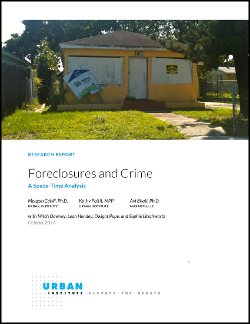
Despite growing attention to the negative neighborhood-level consequences of foreclosures, very little systematic research on the outcomes of the foreclosure crisis was being conducted through the late 2000s. In 2010, the Urban Institute’s Justice Policy Center did an assessment of the impacts of foreclosures and crime levels on each other, using sophisticated spatial analysis methods, informed by qualitative research on the topic.
Four central research questions guided the present research:
1. What is the effect of foreclosures on the levels of crime in a neighborhood and how does that relationship change over time? Do the two phenomena have a circular relationship (where each affects the other simultaneously)?
2. Do foreclosures in one area have a “spillover” effect, increasing crime in a neighboring area at an immediate or later time period?
3. How do the effects of foreclosures on crime differ in the short-, medium-, and long-term?
4. What are the perceptions of key informants and residents on foreclosures and crime in their neighborhoods, on the impact of foreclosures on the crime rate, and on the best approaches to addressing the spillover effects of the foreclosure crisis?
The analysis suggests that any observed relationship between foreclosures and crime exists, more or less, because both foreclosures and crime happen in disadvantaged neighborhoods. Given this evidence, there is no reason to conclude that concentrated foreclosures, at least to the extent experienced in Washington, DC or Miami in the late 2000s, led to significant increases in crime on their own.
Therefore, the authors suggest that policies should not be designed to address these two phenomena alone. Instead, any policy responses should be designed to address wider community problems or disadvantage that likely lead to both higher foreclosures and higher crime.
